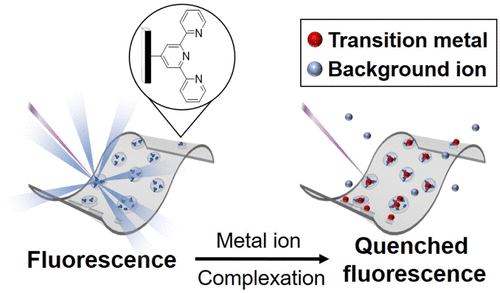当前位置:
X-MOL 学术
›
ACS Cent. Sci.
›
论文详情
Our official English website, www.x-mol.net, welcomes your
feedback! (Note: you will need to create a separate account there.)
High-Affinity Detection and Capture of Heavy Metal Contaminants using Block Polymer Composite Membranes
ACS Central Science ( IF 12.7 ) Pub Date : 2018-12-06 00:00:00 , DOI: 10.1021/acscentsci.8b00690 Yizhou Zhang 1 , Joseph R Vallin 1 , Jugal Kishore Sahoo 1 , Feng Gao 1 , Bryan W Boudouris 2, 2 , Matthew J Webber 1 , William A Phillip 1
ACS Central Science ( IF 12.7 ) Pub Date : 2018-12-06 00:00:00 , DOI: 10.1021/acscentsci.8b00690 Yizhou Zhang 1 , Joseph R Vallin 1 , Jugal Kishore Sahoo 1 , Feng Gao 1 , Bryan W Boudouris 2, 2 , Matthew J Webber 1 , William A Phillip 1
Affiliation

|
Adsorptive membranes offer one possible solution to the challenge of removing and recovering heavy metal ion contaminants and resources from water supplies. However, current membrane-based sorbents suffer from low binding affinities, leading to issues when contaminants are present at trace concentrations or when the source waters have a high concentration of background electrolytes that compete for open binding sites. Here, these challenges are addressed in the design of a highly permeable (i.e., permeability of ∼2.8 × 104 L m–2 h–1 bar–1) sorbent platform based on polysulfone and polystyrene-b-poly(acrylic acid) composite membranes. The membranes possess a fully interconnected network of poly(acrylic acid)-lined pores, which enables the surface chemistry to be tailored through sequential attachment of polyethylenimine brushes and metal-binding terpyridine ligands. The polyethylenimine brushes increase the saturation capacity, while the addition of terpyridine enables high-affinity binding to a diversity of transition metal ions (i.e., Pd2+, Cd2+, Hg2+, Pb2+, Zn2+, Co2+, Ni2+, Fe2+, Nd3+, and Sm3+). This platform removes these metal contaminants from solution with a sorbent capacity of 1.2 mmol g–1 [based on Cu2+ uptake]. The metal capture performance of the functionalized membranes persists in spite of high concentrations of competitive ions, with >99% removal of Pb2+ and Cd2+ ions from artificial groundwater and seawater solutions. Breakthrough experiments demonstrate the efficient purification of feed solutions containing multiple heavy metal ions under dynamic flow conditions. Finally, fluorescence quenching of the terpyridine moiety upon metal ion complexation offers an in situ probe to monitor the extent of sorbent saturation with a Stern–Volmer association constant of 2.9 × 104 L mol–1. The permeability, capacity, and affinity of these membranes, with high-density display of a metal-binding ligand, offer a chemically tailored platform to address the challenges that arise in ensuring clean water.
中文翻译:

使用嵌段聚合物复合膜高亲和力检测和捕获重金属污染物
吸附膜为解决从供水中去除和回收重金属离子污染物和资源的挑战提供了一种可能的解决方案。然而,当前的基于膜的吸附剂的结合亲和力较低,当污染物以痕量浓度存在或源水中具有高浓度的背景电解质竞争开放结合位点时,就会导致问题。在这里,这些挑战通过设计基于聚砜和聚苯乙烯-b-聚(丙烯酸)复合材料的高渗透性(即渗透性~2.8 × 10 4 L m –2 h –1 bar –1 )吸附剂平台得到解决膜。该膜具有完全互连的聚丙烯酸内衬孔网络,这使得能够通过顺序连接聚乙烯亚胺刷和金属结合三联吡啶配体来定制表面化学。聚乙烯亚胺刷增加了饱和容量,而三联吡啶的添加使得能够与多种过渡金属离子(即Pd 2+、Cd 2+、Hg 2+、Pb 2+、Zn 2+、Co 2 )高亲和力结合。 +、Ni 2+、Fe 2+、Nd 3+和Sm 3+ )。该平台可从溶液中去除这些金属污染物,吸附剂容量为 1.2 mmol g –1 [基于 Cu 2+吸收]。尽管存在高浓度的竞争性离子,功能化膜的金属捕获性能仍然存在,从人工地下水和海水溶液中去除>99%的Pb 2+和Cd 2+离子。突破性实验证明在动态流动条件下可以有效纯化含有多种重金属离子的进料溶液。最后,金属离子络合时三联吡啶部分的荧光猝灭提供了一种原位探针,用于监测吸附剂饱和程度,Stern-Volmer 缔合常数为 2.9 × 10 4 L mol –1。这些膜的渗透性、容量和亲和力,以及金属结合配体的高密度显示,提供了一个化学定制的平台,以解决在确保清洁水方面出现的挑战。
更新日期:2018-12-06
中文翻译:

使用嵌段聚合物复合膜高亲和力检测和捕获重金属污染物
吸附膜为解决从供水中去除和回收重金属离子污染物和资源的挑战提供了一种可能的解决方案。然而,当前的基于膜的吸附剂的结合亲和力较低,当污染物以痕量浓度存在或源水中具有高浓度的背景电解质竞争开放结合位点时,就会导致问题。在这里,这些挑战通过设计基于聚砜和聚苯乙烯-b-聚(丙烯酸)复合材料的高渗透性(即渗透性~2.8 × 10 4 L m –2 h –1 bar –1 )吸附剂平台得到解决膜。该膜具有完全互连的聚丙烯酸内衬孔网络,这使得能够通过顺序连接聚乙烯亚胺刷和金属结合三联吡啶配体来定制表面化学。聚乙烯亚胺刷增加了饱和容量,而三联吡啶的添加使得能够与多种过渡金属离子(即Pd 2+、Cd 2+、Hg 2+、Pb 2+、Zn 2+、Co 2 )高亲和力结合。 +、Ni 2+、Fe 2+、Nd 3+和Sm 3+ )。该平台可从溶液中去除这些金属污染物,吸附剂容量为 1.2 mmol g –1 [基于 Cu 2+吸收]。尽管存在高浓度的竞争性离子,功能化膜的金属捕获性能仍然存在,从人工地下水和海水溶液中去除>99%的Pb 2+和Cd 2+离子。突破性实验证明在动态流动条件下可以有效纯化含有多种重金属离子的进料溶液。最后,金属离子络合时三联吡啶部分的荧光猝灭提供了一种原位探针,用于监测吸附剂饱和程度,Stern-Volmer 缔合常数为 2.9 × 10 4 L mol –1。这些膜的渗透性、容量和亲和力,以及金属结合配体的高密度显示,提供了一个化学定制的平台,以解决在确保清洁水方面出现的挑战。











































 京公网安备 11010802027423号
京公网安备 11010802027423号